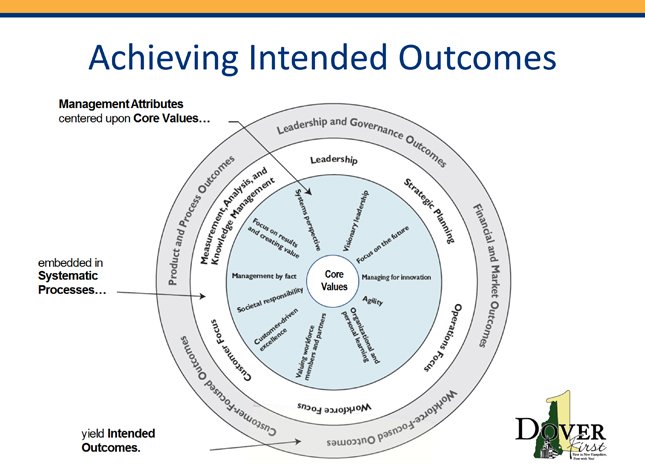- About Dover
- Business in Dover
- City Government
- City Services
- Budget Revealed »
- Building Inspection Services Permits and Forms »
- Current Bids »
- DNTV On Demand»
- Election Information »
- Employment »
- Motor Vehicle Registration »
- Online Permits»
- Planning»
- Pay My Bill»
- Public Library »
- Public Welfare »
- Public Safety »
- Recreation »
- Recycling Center»
- Tax Assessment »
- Vital Records»
- Water and Sewer Billing»
- Contact Us
Intended Outcomes
Intended Outcomes
The strategic management framework employed in Dover focuses on key areas of operational performance and their specific areas of intended outcomes, as indicated below.
Operational performance areas:
(a) Customer-focused outcomes;
(b) Product and process outcomes;
(c) Leadership and governance outcomes;
(d) Financial and benchmark outcomes;
(e) Workforce-focused outcomes

Customer-Focused Outcomes
Customer focused performance results demonstrate how successful our municipal organization has been in satisfying various stakeholders. Relevant data and information include customer satisfaction and dissatisfaction; program participation levels; customer complaints, complaint management, and effective complaint resolution; customer-perceived value based on quality and cost; customer assessment of access and ease of use (including courtesy extended in service interactions); customer advocacy for services; and awards, ratings, and recognition from customers and independent rating organizations. Customer-focused results that go beyond satisfaction measurements are also included, because customer engagement and ongoing relationship development contribute to future service success and organizational sustainability.
Product and Process Outcomes
Product and process results demonstrate product and service quality and value that lead to general customer satisfaction and engagement. Work system and work process effectiveness and efficiency measurements include internal quality measurements, field performance, defect levels, service errors, response times, and data collected from customers by other organizations on ease of use or other attributes, as well as customer surveys on product and service performance.
More specific effectiveness and efficiency indicators include work system performance measures that demonstrate improved cost savings or higher productivity by using internal and/or external resources; reduced emission levels or energy consumption, waste stream reductions, by-product use, and recycling; internal service responsiveness, cycle times, production flexibility, lead times, and set-up times; and improved performance of administrative and other support functions.
Leadership and Governance Outcomes
Senior leadership and governance measures and indicators demonstrate a fiscally sound, ethical organization that fulfills its societal responsibilities supporting the needs of the community. Results reported include environmental, legal, and regulatory compliance; results of oversight audits by government or funding agencies; and noteworthy achievements in these areas, as appropriate.
Financial and Market Outcomes
Key financial and benchmark results demonstrate financial sustainability and achievements in comparison to other similarly situated organizations. Measures are tracked on an ongoing basis to assess financial performance and viability. Financial performance indicators include revenues, budgets, net income, cash position, net assets, debt levels, financial operations efficiency (collections, billing, receivables), and grants received.
Workforce-Focused Outcomes
Workforce-focused results demonstrate how well our municipal organization has been in creating and maintaining a productive, caring, engaging, and learning environment for all members of the workforce. Results include employee safety, absenteeism, turnover, satisfaction, and complaints (grievances). Other factors include the extent of training, retraining, or cross-training to meet capability and capacity needs; the extent and success of self-direction; the extent of union-management partnering; the extent of volunteer involvement in process and program activities; staffing levels across work units; and certifications completed to meet skill needs.
Want to know more? Subscribe to the City's weekly newsletter, Dover Download. Click Here. Our Web Policy | Site Map | Contact the webmaster